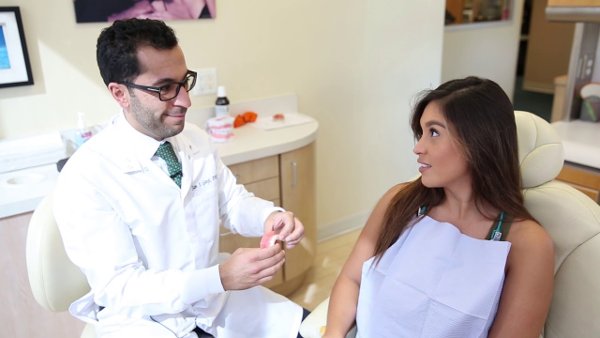If you have a problem with your teeth, you may never enjoy smiling. Cosmetic dentistry procedures help you achieve a smile you are proud to show off. When you can smile all the time, you are more likely to feel confident and happy. And when you are confident and happy, you are more likely to enjoy a successful life. Among the many procedures that can give you back your beautiful smile is dental bonding. It is a dental procedure that significantly improves your cracked, chipped, or discolored teeth. It is affordable and effective and will leave you happier than you have ever been.
If you are looking for dental bonding services in Carson, CA, contact us at Washington Dental. We are a full-service dental office offering affordable and quality dental care. Let us offer you our unbeatable services and give you a reason to smile again.
Tooth Bonding —Overview
Your natural teeth are beautiful and strong and will enable you to chew and smile, at least for the length of your life. However, most people do not enjoy all these and other benefits of natural teeth for different reasons. For some, their teeth weaken and break along the way, making it impossible for them even to smile. Chipped teeth happen for reasons such as car accidents, falls, biting down on hard surfaces/foods, and accidents when playing contact sports. It is increasingly easy to chip your tooth if you suffer from bruxism, tooth decay, or abnormally high acids that eat away your tooth enamel.
Chipped teeth do not feel or look good. You might have to look for a solution soon if you wish to smile and enjoy the full functionality of your natural teeth. Cosmetic dentistry is a lifesaver for people who are not yet ready to give up on their natural teeth.
Certain procedures are designed to improve the strength, appearance, and functionality of natural teeth. Among them is teeth bonding. You can undergo this dental procedure to repair your chipped or broken teeth and inhibit further damage to your natural teeth. It is affordable, quick to perform, and can leave you feeling happier and more confident than before.
Tooth/dental bonding is a cosmetic dental treatment that could repair chipped, broken, or cracked teeth. It can also improve discolored teeth, take care of gaps between teeth, and lengthen natural teeth that look shorter than the others.
The procedure involves using composite resin material as a bond where your natural tooth is broken or chipped to make it appear brand new. Cosmetic dentists use composite resin in procedures like these because the color of the composite is similar to that of a natural tooth. Their goal is to leave your teeth looking as natural as possible.
People can be shy if there is something wrong with their teeth. It can affect your confidence and social life. A chipped, broken, or discolored tooth is enough to take your enthusiasm and happiness away. Fixing dental issues like those is good for your smile and your oral health, and general well-being. For instance, a broken tooth could make it hard for you to bite or chew. Bonding fixes the crack to prevent further damage to the tooth. It also protects the surrounding teeth from damage to keep all your teeth functional.
Who Undergoes Dental Bonding
Dental bonding is an excellent treatment for adults whose permanent teeth have suffered minor injuries. The affected tooth must not be harshly decayed. Otherwise, bonding will not be effective in salvaging the tooth. You must also be willing to save the affected tooth because that is what bonding will do.
If your tooth is severely damaged or is lost, other cosmetic dental procedures like dental implants could benefit you. Dental implants replace the affected tooth and its roots by the use of an implant and porcelain crown. It is best to seek the help of an experienced dentist to determine the right procedure for your problem.
If your tooth is chipped, consider dental bonding right away before the damage worsens. It will be easy and less costly to treat a minor than significant damage. Again, bonding aims at keeping much of your natural tooth.
Dental bonding is also the right procedure for dental patients who are already comfortable with the color of their teeth. The process entails treating the affected tooth with a material of the same color as your teeth. If you’ve always desired whiter teeth, it is advisable to go for teeth whitening before undergoing a dental bonding procedure. If you go for teeth whitening after bonding, the enamel of your teeth will appear much lighter than the bond, which never changes its color.
As it is, dental bonding is suitable for all kinds of people. However, it is best to consult with an experienced dentist first before making the final decision. If you feel that you have one of the issues discussed above and could benefit from dental bonding, allow your dentist to assess the condition of your teeth. If you have any other dental issue like gum infection, it will be best to have it treated first before undergoing the procedure.
The Procedure
Skilled dentists perform dental bonding procedures. The procedure entails attaching a tooth-colored resin material to a discolored, decayed, chipped, or cracked tooth using an adhesive and then hardening it with unique lights. The aim is to introduce a material that looks exactly like your natural teeth to the affected tooth to restore its feel and appearance and improve your smile.
Tooth bonding is majorly optional and only done for dental patients who would like to improve the appearance and functionality of their damaged natural teeth.
Dental bonding can be performed for the following reasons:
- To repair tooth decay — The composite resin material can be used to fill dental cavities
- To repair cracked or chipped teeth
- To improve the appearance of discolored teeth
- To make shorter teeth appear longer and uniform
- To close spaces between teeth
- To alter the shape of a tooth
- To protect the part of the tooth’s root that is exposed due to gum recession.
- As a cosmetic substitute to amalgam fillings
There are mainly two types of dental bonding you can choose from:
- Direct composite bonding — It is the type of dental bonding used to repair chipped or cracked teeth. It can also be used to fill cavities. The procedure is completed on one visit to a dentist’s office and is inexpensive. It mainly involves repair for minor dental issues.
- Adhesive bonding — It is a form of dental bonding that uses an adhesive or glue to hold crowns, veneers, and bridges in place during dental restoration procedures.
During the dental bonding procedure, your dentist applies resin on the chipped or decayed tooth and then shapes the material based on the measurements of your affected tooth. Once the correct shape is achieved, the dentist will polish the tooth to match it to the natural color of your teeth.
This form of treatment is an in-and-out dental procedure that won’t require anesthesia unless in cases where the patient needs a filling or your dentist has to shape the tooth after restoration dramatically. You might also need anesthesia if the damage on your tooth is close to a nerve. As the dentist works on your tooth, it could be painful if he/she bumps on a nerve.
To start the process, your dentist will examine the health of your teeth to ensure that they are in good health and can support the procedure. Then, he/she will choose a composite resin material whose color comes very close to the color of your natural teeth. Cosmetic dentists use a particular chart that provides a correct color match.
Once your dentist is sure of the resin material to use for the procedure, he/she will prepare to bond the composite resin material to your existing natural tooth. The resin material will be attached to the exact place where the tooth is damaged. Your dentist will create a rough surface on the affected tooth to make the attachment easy and then apply a bonding agent. He/she will finally attach the composite material to the prepared tooth.
Once the material is attached, it will not automatically take the shape of the natural tooth. Therefore, your dentist will mold it as carefully as possible to take the shape of the affected tooth and repair the damage on the tooth when he/she is sure that the shape and size of the bond are correct. Your dentist will use a UV light to dry it.
The bond might not look or feel perfect the first time. But a little more shaping by your dentist after the resin has dried will bring it to the right shape and size.
Advantages of Dental Bonding
Dental bonding comes with several advantages you should know about before choosing it for your teeth repair:
It’s Affordable
Cosmetic dentistry can be costly and not affordable to many people. Most patients choose to live with imperfect teeth because they cannot afford to have them treated. However, dental bonding is one cosmetic dentistry procedure that you can easily afford. The cost of the procedure depends on your location, the extent of the procedure, and your dentist’s expertise. The overall cost will also depend on the number of affected teeth.
The procedure doesn’t take a long time, thus cutting on the service costs. You only need one visit to the dentist’s office to have your teeth treated. This saves you time and money spent on the road.
The good thing is that the bond can last for up to five or ten years without requiring additional treatment in between. If you take well care of the treated tooth, you’ll get good value for your money.
It Covers Tooth Imperfections
An imperfect tooth affects the way you feel about yourself. That is why people with broken, decayed, discolored or even chipped teeth do not smile confidently. Dental bonding helps cover a wide range of teeth imperfections, including minor cracks and chips caused by injuries or accidents.
Today, dentists use cosmetic dentistry to take care of teeth imperfections that would otherwise be hard to treat. For instance, if your teeth are discolored due to eating certain foods or smoking, a bond can be used to whiten those stains. It can also be used to replace a particular part of your decayed tooth or give your teeth a perfect shape and length.
The Best Alternative to Amalgam Fillings
Dental fillings are used to treat cavities in cases where the original tooth can be saved. Fillings are applied to the cavity to give the affected tooth more structure and strength. The problem with amalgam fillings is that they come in a distinct color that makes them noticeable. Everyone will know that you have had a filling on a particular tooth. That is why it is hard to feel confident even after treatment.
However, dental bonding provides an excellent alternative to amalgam fillings. Unlike amalgam fillings, bonding is done using a composite resin material that blends perfectly with your natural teeth. After treatment, you can smile and enjoy life since no one will know that you had a cavity treated.
It’s Easy and Quick
If you do not like lengthy dental procedures, dental bonding is a procedure you can undergo for perfectly looking teeth. The procedure is easy and quick and is finished in just a few minutes. The procedure is also safe and painless. You might not need anesthesia unless you need another dental procedure before bonding. Once the problematic tooth is identified, your dentist will apply a chemical compound on the affected part to roughen it a little and make it easy for the bonding material to attach to the tooth.
Then the dentist will apply the bonding resin in layers, depending on the required thickness of your tooth. Finally, he/she will shape the resin before hardening it using UV light. It will take about 30 minutes to one hour for your dentist to finish the entire procedure. In just one sitting, you’ll have all your imperfect teeth looking great once more. However, if more teeth are damaged, it might take a longer time to have them treated.
Disadvantages of Dental Bonding
Even with all the benefits of dental bonding, the procedure has some disadvantages worth considering, especially if you want to make the right decision for your situation. Some of them are:
It is Less Durable Than Most Cosmetic Dentistry Procedures
Durability is a major concern for people who choose cosmetic dentistry to improve the look and feel of their teeth. Since cosmetic dentistry is generally expensive, no one wants to pay so much money for a procedure they might not enjoy for long.
First, the material used for bonding is usually a plastic called composite resin. The material is strong but not as durable as your tooth’s enamel. It is also not as strong as porcelain and other materials used for dental crowns and veneers.
Thus, you might have to go the extra mile in ensuring that your bonded teeth serve you longer than they possibly can. For instance, you have to be careful when biting down or eating hard foods lest your bonded teeth will break or chip.
If, for any reason, your teeth start feeling jagged or rough, or your bite becomes uneven, you must visit a dentist to see if it requires a replacement or just to be filed.
Dental Bonding is Not Long Lasting
Since dental bonding is not as robust as its alternatives, it has a shorter shelf-life. Thus, prepare to have a replacement a few years after the first treatment. Generally, bonding is expected to serve you well for between five and ten years. The exact time depends on how well you’ll take care of your teeth and gums, your lifestyle, and your habits. It is advisable to follow the after-care instruction provided by your dentist if you wish to enjoy the treatment for a longer time.
Again, ensure you visit your dentist regularly or at least every six months. If your dentist notices a developing problem, he/she can fix it immediately before it worsens and becomes expensive to repair.
Bonds Are Not Stain Resistant
The material used for dental bonding is not particularly resistant to stains. Composite resin is, in fact, more porous than tooth enamel. It can absorb color from foods more easily. Therefore, if you regularly consume deep-colored foods like red wine, coffee, or berries, you could notice discoloration on your treated teeth soon. You might have to do away with foods like those or only consume in moderation to be safe. It makes dental bonding quite restrictive, especially since you have to be careful with what and how you eat it.
Taking Care of Bonded Teeth
Your teeth require proper care to remain strong and healthy. Bonded teeth may not be as strong and durable as your natural teeth, but they can still serve the purpose if they are well cared for. Even though the bond has repaired the problem you had on your tooth/teeth, you still have to care for it if you wish to enjoy the repair for much longer.
First, be careful about the kinds of foods you bite on and chew. As previously mentioned, dental bonding is not as durable as cosmetic dentistry procedures like crowns and veneers. Thus, you might undo the repair even before you enjoy its service. Therefore, if you are in the habit of chewing on pens and ice cubes, you might want to slow down on that. Minimize other hard foods like candies, too, as much of them could be damaging to your bond.
If your teeth are prone to breaking or chipping, they are not strong enough to withstand hard foods without bonding. You must take care of your remaining healthy teeth even as you take care of the treated ones.
Again, remember that composite resin stains very quickly. It absorbs stains faster than your teeth’ enamel. Therefore, it is advisable to avoid highly-staining foods like tea, coffee, and wine. You might want to consider quitting smoking too.
Lastly, always maintain good oral health practices to keep your teeth and entire mouth clean and healthy. Some of the practices you must stick to include:
- Brushing your teeth at least twice every day
- Flossing your teeth at least once a day
- Rinsing your mouth using an antiseptic mouthwash at least once every day
- Visiting your dentist for regular professional cleaning and checkups
Bonding is Reversible
Dental bonding is not a permanent cosmetic dentistry procedure. It doesn’t involve the removal of your tooth’s enamel. Thus, if along the way you feel like you would like to change the appearance of your bonded tooth by going for an alternative procedure, your dentist can quickly reverse the process. Dental bonding is a temporary solution for minor dental issues. If there will be a need for a more permanent solution in the future, you can have the bond removed quickly without worrying about losing your tooth.
However, the satisfaction rate for people who have undergone dental bonding is still very high. You may not need to choose an alternative procedure once you have successfully gone through bonding.
Find a Cosmetic Dentist Near Me
Cosmetic dentistry is changing the lives of millions of people across the globe. You no longer have to live with damaged teeth. The advanced technology has brought with it so many dental procedures you can choose from, depending on the exact problem you are experiencing with your teeth. Dental bonding is inexpensive, easy and quick, and an effective solution for discolored chipped or broken teeth. If you would like to learn more about dental bonding in Carson, CA, contact Washington Dental at 310-217-1507. We have the skills and knowledge to guide and help you make the right decision for stronger and more functional teeth.







